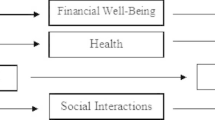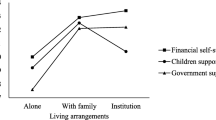Abstract
This study investigates the relationship between intergenerational co-residence and the subjective well-being (SWB) of elders based on the individual-level panel data collected from the Chinese Longitudinal Healthy Longevity Survey from 2002 to 2014. We use the endogenous treatment effect model to minimize selection bias and estimate the causal impacts of intergenerational co-residence on parental SWB. In addition, we employ the individual fixed-effect model for robustness checks. Results corroborate that elders who live with their adult–children are happier than those who do not undergo such a living arrangement. We also investigate heterogeneous effects across geographical regions and demographic groups. Older people in rural areas who co-reside with their adult–children gain a more substantial co-residence effect compared with those in urban areas. Moreover, results are robust according to different specifications. Our findings provide useful implications for policymakers in promoting the SWB of elders.

Similar content being viewed by others
Notes
For instance, the “one-child policy” was introduced in 1979 and eliminated by the end of 2015.
E.g., China, Europe, South Korea, Vietnam and Thailand, and Spain.
E.g., Europe and Indonesia.
Given the availability and validity of data in questionnaires, the missing and invalid observations are excluded in the sample.
The dialect diversity index in city \(i\) is measure as follows: \(Dialect\;Diversity_{i} = 1 - \mathop \sum \limits_{k = 1}^{N} W_{ki}^{2}\); where \(N\) denotes the number of dialects used in this city; \(W_{ki}\) indicates the proportion of people using dialect \(k\) in city \(i\). The values of the dialect diversity index are between 0 and 1. This index can be interpreted as the possibility of speaking different dialects for two randomly selected persons in a particular city. The higher the value, the more diversity in dialects. The data source is from Xu et al. (2015).
The procedure is implemented in Stata command “treatoprobitsim” as proposed by Gregory (2015).
Twoway-clustering is allowed in Stata command “reghdfe”. Thus, we indicate the interactions of city and year such that we can estimate consistent standard errors even when the observations are correlated within groups.
The instrument can only identify those individuals living in areas with relatively prevalent co-residence culture and decide to live with their adult–children. Thus, IV estimation only identifies the effects of those who can be switched from not co-residence into co-residence, which is the local average treatment effect (LATE) rather than average treatment effect (ATE). Actually, the switchers are more likely to benefit from co-residence with adult children. The causal impact comes from a selected part of the population.
Underidentification test null hypothesis: the excluded instrument is uncorrelated with the endogenous variable. The Anderson canon. corr. LM statistic is 34.290; P value = 0.0000. The result shows that the null hypothesis is rejected at 1% level, which means the equation is identified.
Weak identification test null hypothesis: the instruments are weak despite their correlation with the endogenous variable. The Cragg-Donald Wald F statistic is 17.158; the null hypothesis can be rejected according to the rules of thumb.
Overidentification test of all instruments null hypothesis: the instruments are valid. The Sargan statistic is 2.558; P value = 0.1097. The null hypothesis cannot be rejected.
In urban areas, rural immigrants may treat co-residence with older parents as an extra financial burden due to the high living costs and housing shortage. Conversely, higher housing prices may encourage urban parents to live with their adult child to reduce costs.
References
Aakvik, A., Heckman, J. J., & Vytlacil, E. J. (2005). Estimating treatment effects for discrete outcomes when responses to treatment vary: An application to Norwegian vocational rehabilitation programs. Journal of Econometrics, 125, 15–51.
Aranda, L. (2015). Doubling up: A gift or a shame? Intergenerational households and parental depression of older Europeans. Social Science and Medicine, 134, 12–22.
CHARLS. (2013) Challenges of population aging in China: evidence from the national baseline survey of the China Health and Retirement Longitudinal Study (CHARLS).
Chen, F., & Short, S. E. (2008). Household context and subjective well-being among the oldest old in China. Journal of Family Issues, 29, 1379–1403.
Chen, X., & Silverstein, M. (2000). Intergenerational social support and the psychological well-being of older parents in China. Research on Aging, 22, 43–65.
Cheng, P., Jin, Y., Sun, H., et al. (2015). Disparities in prevalence and risk indicators of loneliness between rural empty nest and non-empty nest older adults in C hizhou, C hina. Geriatrics & Gerontology International, 15, 356–364.
Cong, Z., & Silverstein, M. (2008). Intergenerational support and depression among elders in Rural China: Do daughters-in-law matter? Journal of Marriage & Family, 70, 599–612.
Connelly, R., Iannotti, M., Maurer-Fazio, M., et al. (2014). Coresidency, ethnicity, and happiness of China’s rural elders. Eurasian Geography and Economics, 1, 1–19.
Correia S. (2016) REGHDFE: Stata module to perform linear or instrumental-variable regression absorbing any number of high-dimensional fixed effects.
Courtin, E., & Avendano, M. (2016). Under one roof: The effect of co-residing with adult children on depression in later life. Social Science and Medicine, 168, 140–149.
Do, Y. K., & Malhotra, C. (2012). The effect of coresidence with an adult child on depressive symptoms among older widowed women in South Korea: an instrumental variables estimation. Journals of Gerontology. Series B, Psychological Sciences and Social Sciences, 67, 384–391.
Ferrer-i-Carbonell, A., & Frijters, P. (2004). How important is methodology for the estimates of the determinants of happiness? The Economic Journal, 114, 641–659.
Glass, T. A., De Leon, C. F. M., Bassuk, S. S., et al. (2006). Social engagement and depressive symptoms in late life: Longitudinal findings. Journal of Aging and Health, 18, 604–628.
Gregory, C. A. (2015). Estimating treatment effects for ordered outcomes using maximum simulated likelihood. The Stata Journal, 15, 756–774.
Grundy, E., & Murphy, M. (2018). Coresidence with a child and happiness among older widows in Europe: Does gender of the child matter? Population Space & Place, 24, e2102.
Hsu, F. L. (1998). Confucianism in comparative context. Confucianism and the family, 1, 537–571.
Johar, M., & Maruyama, S. (2014). Does coresidence improve an elderly parent’s health? Journal of Applied Econometrics, 29, 965–983.
Kim, H.-J., Hong, S., & Kim, M. (2015). Living Arrangement, Social Connectedness, and Life Satisfaction among Korean Older Adults with Physical Disabilities: The Results from the National Survey on Persons with Disabilities. Journal of Developmental and Physical Disabilities, 27, 307–321.
Lei, L. (2013). Sons, daughters, and intergenerational support in China. Chinese Sociological Review, 45, 26–52.
Liu, L.-J., Fu, Y.-F., Qu, L., et al. (2014). Home health care needs and willingness to pay for home health care among the empty-nest elderly in Shanghai, China. International Journal of Gerontology, 8, 31–36.
Manacorda, M., & Moretti, E. (2011). Why do most Italian youths live with their parents? Intergenerational transfers and household structure. Journal of the European Economic Association, 4, 800–829.
Maruyama, S. (2012). Inter vivos health transfers: Final days of japanese elderly parents. UNSW Australian School of Business Research Paper No. 2012ECON20. https://ssrn.com/abstract=2028711.
Miao, J., Wu, X., & Sun, X. (2018). Neighborhood, social cohesion, and the Elderly’s depression in Shanghai. Social Science and Medicine, 229, 134–143.
Michael, Y. L., Berkman, L. F., Colditz, G. A., et al. (2001). Living arrangements, social integration, and change in functional health status. American Journal of Epidemiology, 153, 123–131.
Oster, E. (2019). Unobservable selection and coefficient stability: Theory and evidence. Journal of Business & Economic Statistics, 37(2), 187–204.
Pendakur, K., & Pendakur, R. (2002). Language as both human capital and ethnicity. International Migration Review, 36(1), 147–177.
Radloff, L. S. (1977). The CES-D scale: A self-report depression scale for research in the general population. Applied Psychological Measurement, 1(3), 385–401.
Raftery, A. E., Alkema, L., & Gerland, P. (2014). Bayesian population projections for the United Nations. Statistical Science: A Review Journal of the Institute of Mathematical Statistics, 29, 58.
Ren, Q., & Treiman, D. J. (2015). Living Arrangements of the Elderly in China and Consequences for Their Emotional Well-being. Chinese Sociological Review, 47, 255–286.
Silverstein, M., Gans, D., & Yang, F. M. (2006). Intergenerational support to aging parents: The role of norms and needs. Journal of Family Issues, 27, 1068–1084.
Tang, D., Lin, Z., & Chen, F. (2019). Moving beyond living arrangements: the role of family and friendship ties in promoting mental health for urban and rural older adults in China. Aging and Mental Health, 1, 1.
Teerawichitchainan, B., Pothisiri, W., & Long, G. T. (2015). How do living arrangements and intergenerational support matter for psychological health of elderly parents? Evidence from Myanmar, Vietnam, and Thailand. Social Science and Medicine, 136–137, 106–116.
Tosi, M., & Grundy, E. (2018). Returns home by children and changes in parents’ well-being in Europe. Social Science and Medicine, 200, 99–106.
UN. (2017a). United Nations, Department for Economic Social Affairs. World population prospects: the 2017 revision: Volume II: Demographic Profiles. ST/ESA/SER.A/400.
UN. (2017b) United Nations, Department of Economic and Social Affairs, Population Division, World Population Ageing 2017—Highlights (ST/ESA/SER.A/397).
Wang, Y., Sun, W., & Wang, X. (2019). Motivation of parent-child co-residence behavior: Evidence from the China health and retirement longitudinal study. China & World Economy, 27, 66–85.
Xie, Y., & Zhu, H. (2009). Do sons or daughters give more money to parents in urban China? Journal of Marriage and Family, 71, 174–186.
Xu, X., Liu, Y., & Xiao, Z. (2015). Dialect and Economic Growth (in Chinese). China Journal of Economics, 2, 1–32.
Zunzunegui, M. V., Beland, F., & Otero, A. (2001). Support from children, living arrangements, self-rated health and depressive symptoms of older people in Spain. International Journal of Epidemiology, 30, 1090–1099.
Funding
Funding was provided by the Ministry of education of Humanities and Social Science (Grant No. 16YJC790149), National Natural Science Foundation of China (Grant No. 71603101), Fundamental Research Funds for Central Universities of the Central South University (CN) (Grant No. Jinan University, No. 19JNQM19).
Author information
Authors and Affiliations
Corresponding author
Additional information
Publisher's Note
Springer Nature remains neutral with regard to jurisdictional claims in published maps and institutional affiliations.
Appendix
Appendix
See Tables 7, 8, 9, 10, 11, 12, 13, 14, 15, 16, 17 and 18.
Rights and permissions
About this article
Cite this article
Yuan, Zq., Zheng, X. & Hui, E.C.M. Happiness Under One Roof? The Intergenerational Co-residence and Subjective Well-Being of Elders in China. J Happiness Stud 22, 727–765 (2021). https://doi.org/10.1007/s10902-020-00249-1
Published:
Issue Date:
DOI: https://doi.org/10.1007/s10902-020-00249-1




